Kendall Simmons and His T1D Diagnosis in the NFL
Written by: Michelle Boise
4 minute read
January 4, 2016
Editor’s Note: Get involved in Beyond Type 1’s #SeeTheSigns of diabetes campaign! Share your signs to help save lives, request #SeeTheSigns posters to share in your community, get sharable graphics for social media and more! Learn more here.
Defensive lineman Kendall Simmons started for the Pittsburg Steelers his first two years of his professional football career. Before being drafted in the NFL, he’d been listed as a “Mid-South Top 100” player and the No. 2 offensive lineman of Mississippi in 2000.
Then in 2003, at age 23, he was diagnosed with latent autoimmune diabetes in adults (LADA) type 1 diabetes—a form of type 1. Soon after, he suffered an injury and went through rehabilitation through the 2004 season. In 2005, he won the Super Bowl XL, starting all 20 games. Later, he would be signed by the New England Patriots and then the Buffalo Bills, but would eventually retire in 2011 due to injuries.

Now living in Auburn, Alabama, with his wife and five kids, he tells Beyond Type 1 about the shock of his diagnosis while in the NFL, his outlook on life and his love of peppermint candy to bring up his blood sugar.
“I always liked peppermint candy,” says Simmons, “but I didn’t realize what a central part of my life it’d be,” he laughs. “My oldest is my go-to. She knows where all my supplies are and my secret stash of peppermint. It’s either that or cranberry juice.”
When we talk about his kids understanding his type 1 diabetes diagnosis, he explains that he wants to keep it as simple as possible for them. “Sometimes I let them check my blood sugar and help me treat it,” he says. “They say insulin smells sweet.”
“My grandmother had type 2 diabetes,” he says. “We called it ‘sugar’ growing up and didn’t talk much about it. As kids we’d play with her insulin bottle and she’d scold us, saying we’d break it. At the time, I didn’t understand it. She had peppermint candy the size of a miniature baseball bat and she’d break it up in a brown paper bag and give us some. Looking back, I know now that she ate it to bring up her blood sugar.”
 There’s an upbeat easiness about Simmons. You can tell he’s tough, but there’s warmth in his good humor. He tells me he may not survive the weekend watching his five kids while his wife is away. And when we talk about managing the chronic illness in the NFL, he says, “It was difficult and I wouldn’t change anything.”
There’s an upbeat easiness about Simmons. You can tell he’s tough, but there’s warmth in his good humor. He tells me he may not survive the weekend watching his five kids while his wife is away. And when we talk about managing the chronic illness in the NFL, he says, “It was difficult and I wouldn’t change anything.”
There were some in the industry that said he was a “wasted first-round pick” after the diagnosis, but this only motivated him more. He talks about the difficulty of that year, learning how to manage it and getting his strength back. He’d lost 20.4 kg45 pounds in two weeks, went blind for a week and was diagnosed with a blood sugar close to 66.1 mmol/L1100 mg/dL. He was lucky to have survived.
After being on insulin therapy, his doctor said it would be easier to manage his type 1 if he’d lost weight, but as a defensive lineman in the NFL, that wasn’t really an option.
“I was barely 300 pounds,” he says, “and I didn’t have the strength I needed. My doctor advised I take the season off, but I was determined to play and be as strong as I could possibly be.”
Two weeks into training camp, he blew out his knee. That didn’t end his career though. The owner of the Steelers Art Rooney II, who has two kids in his family with type 1 diabetes, told him as he sat injured on the table, “It’s important you feel better. Get your diabetes under control and football will be here.”
Simmons describes the following year of 2005 and how he worked on his management. “At first I didn’t realize how adrenaline was affecting my blood sugar. I started the game at 5.6 mmol/L100 mg/dL and then would jump to 13.9 mmol/L250 mg/dL and try to adjust with insulin. But my body was absorbing insulin too fast—I was taking 8-10 shots a game.”
 “Doctor Rob told me, ‘You have to keep your blood sugars below 10.0 mmol/L180 mg/dL; the higher it gets, it’s like you’re out there with one arm behind your back,’” says Simmons. “I felt like I was in slow motion, like I had cinder blocks on my feet. In the NFL, you can’t afford to be a second late. Targeting that number really helped.”
“Doctor Rob told me, ‘You have to keep your blood sugars below 10.0 mmol/L180 mg/dL; the higher it gets, it’s like you’re out there with one arm behind your back,’” says Simmons. “I felt like I was in slow motion, like I had cinder blocks on my feet. In the NFL, you can’t afford to be a second late. Targeting that number really helped.”
“Having type 1 taught me mental toughness,” explains Simmons. “You can’t let it become a distraction, otherwise, you lose focus of what’s your job.”
Simmons talks about not hiding his type 1 either. All of his teammates knew about his diagnosis. “They are like my brothers and they helped me out if they could,” he says. “If I needed help, they’d get a trainer or they would get my tabs and gels or insulin pens.”
Today, Simmons talks to youth with type 1 diabetes through Novo Nordisk and continues to learn about his type 1 diabetes (T1D) through that opportunity. “This job has been a blessing. Kids are paying attention and it continues to motivate me to stay on track.”
“I’ve been on an insulin pump now for six years, which wouldn’t have survived while I was playing. I love Medtronic 630G and can’t wait for the 670.”
“I’m behaving,” he says, “cycling an average of 75 miles a week.”
When I ask him what he would tell a newly diagnosed athlete, he says, “Whatever you do, there are ways for diabetes to fit into your lifestyle—make it work for you. The first 12-18 months are going to be tough and you’ll be challenged in ways you never thought possible. Injuries happen but you can’t predict these. It will just test you how bad you want it.”

Author
Michelle Boise
Michelle has a BA in English literature and Spanish and a MFA in writing from the University of San Francisco. As a writer, editor and content guru, she's worked on both literary magazines and e-commerce platforms. Before joining the Beyond Type 1 team, she developed health-conscious articles for Fitbit. When she's not writing, you can find her cooking or painting with acrylics (they dry faster). She is an expert decipher in the very serious discipline of finding hidden meaning in the seemingly meaningless.
Related Resources

Already compatible with Dexcom’s G6 and G7 continuous glucose monitors (CGMs), the Omnipod 5 Automated...
Read more

The younger a person is diagnosed with type 2 diabetes, especially those with obesity, the...
Read more

The Oura Ring, which tracks things like sleep, heart rate, and activity, is joining forces...
Read more


